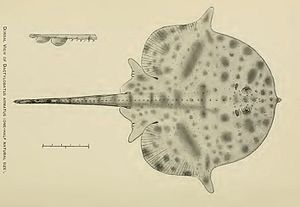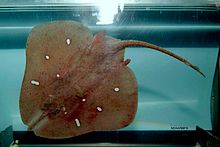Dactylobatus
| Dactylobatus | ||||||||||||
|---|---|---|---|---|---|---|---|---|---|---|---|---|

Dactylobatus armatus , type species of the genus |
||||||||||||
| Systematics | ||||||||||||
|
||||||||||||
| Scientific name | ||||||||||||
| Dactylobatus | ||||||||||||
| Bean & Weed, 1909 |
Dactylobatus is a species of poor species from the family of real rays (Rajidae), which are endemic to the central Atlantic , from the coast of Brazil over the Gulf of Mexico to the coast of South Carolina . They are small to medium in size and native to deeper ocean areas. There they live mainly on continental slopes .
features
According to the genus description of Bean and Weed, based on the first description of Dactylobatus armatus , Dactylobatus have a rounded rather than diamond-shaped body ( heart-shaped in Dactylobatus clarkii ). The central fin rays (rays 6 to 8) of the pectoral fins (pectorals) are elongated on both sides to a finger-shaped process (only type species, absent in Dactylobatus clarkii ). The top of the body disc, like the top of the tail, is studded with thorns and spines. The area with differentiated spines near the outer edge of the pectoral fins as in the species of the genus Raja is apparently missing. The tail is abruptly separated from the body disc as in Raja and does not gradually taper as in other genera such as Rhinobatos and Narcine . The skin flaps on the sides of the tail are rather broad. Near the end of the tail there are two dorsal fins (dorsal), a rudimentary caudal fin (caudal) is present. The pelvic fins (ventral) are not clearly bilobed, their outer edge is only slightly concave . The skull with rostral cartilage extends as in Raja to near the tip of the snout. The tips of the anterior pectoral fin rays reach almost to the level of the tip of the rostral cartilage.
Research history
Among the fish that were collected in deep water off Charleston (South Carolina) in 1885 and 1886 by the research ship USS Albatross, there was a male and a female specimen of a species of ray that were similar to those of the genus Raja , but characterized by the elongated central rays of the fin Distinguished pectoral fins. The species was first described by Bean and Weed as Dactylobatus armatus and the genus Dactylobatus was newly created. The generic name Dactylobatus , from dactyl - finger and lobatus - lobe, refers to the finger-shaped process of the pectoral fins.
species
There are currently only two recognized species within this genus:
- Dactylobatus armatus Bean & Weed , 1909
- Dactylobatus clarkii ( Bigelow & Schroeder , 1958)
Individual evidence
- ^ A b David A. Ebert, Leonard JV Compagno: Biodiversity and systematics of skates (Chondrichthyes: Rajiformes: Rajoidei). In: Environmental Biology of Fishes. 2007, 80, pp. 111-124. ( Online )
- ↑ a b Peter Last, Gavin Naylor, et al. : Rays of the World. 2016, Cornell University Press, ISBN 978-1501705328 , 19.21.
- ^ A b Henry B. Bigelow, William C. Schroeder: Sawfishes, Guitarfishes, Skates and Rays, Chimaeroids: Part 2. Yale, 1953, ISBN 978-1933789125 , p. 323.
- ↑ a b B. A. Bean, AC Weed: Description of a new skate (Dactylobatus armatus) from deep water off the southern Atlantic coast of the United States. 1909 in: Proceedings of the United States National Museum Vol. 36, pp. 459-461. ( Online )
- ↑ Dactylobatus on Fishbase.org (English), last accessed on November 15, 2017.
Web links
- Dactylobatus on Fishbase.org (English)
